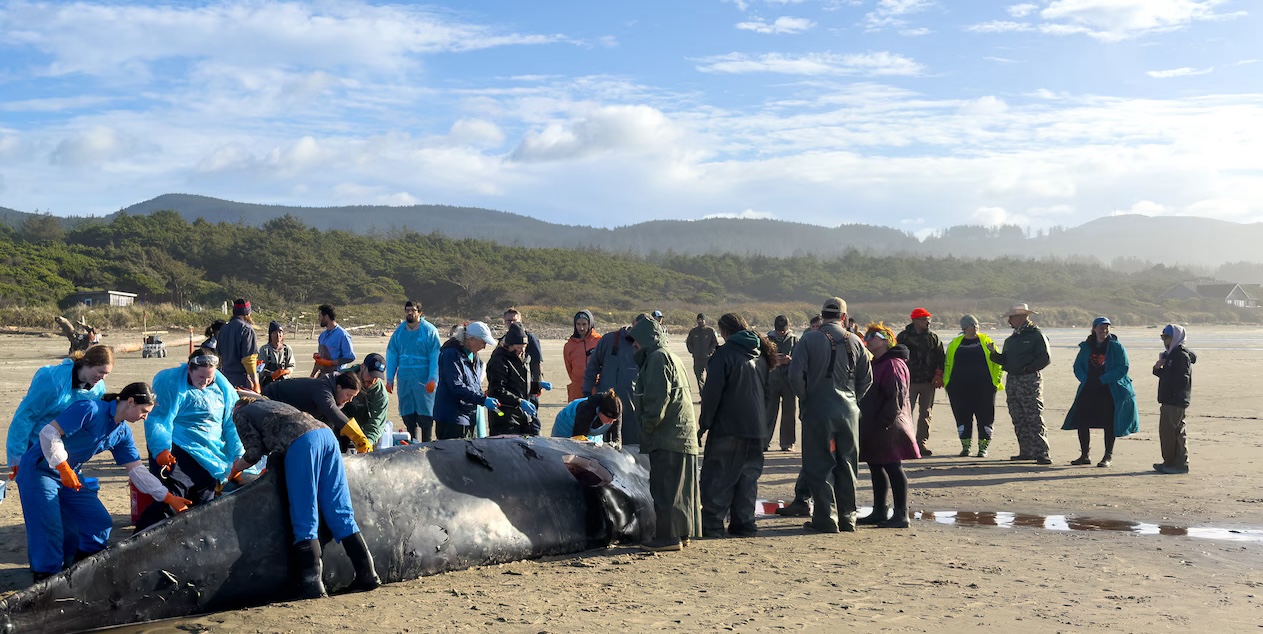
By JAMIE HALE/The Oregonian/OregonLive
Darkness had fallen and the tide was rolling in, lapping at the heels of the team of people who were quickly disassembling the big whale, piece by piece, bone by bone.
The young humpback, 26 feet long and 20,000 pounds in all (roughly the size of a small school bus), had become entangled in crabbing gear and had beached itself two miles north of Yachats last Saturday afternoon.
After two days of efforts to save the whale failed, it was euthanized. After that, it was up to the Siletz tribe to take the whale carcass apart.
Lisa Norton, who works as the chief administrative officer for the Confederated Tribes of Siletz Indians, helped organize the harvest and was a member of the team who worked for nearly 12 hours on the beach Tuesday afternoon and night.
This was the first time in generations that the Siletz tribe has harvested a whale, she said. Nobody in the tribe had ever done it before, and nobody could remember the last time it happened.
Ancestors of some of the 30 bands that make up the tribe hunted and harvested whales, but those cultural practices had long been suppressed by the U.S. government. The Siletz tribe has only recently regained its fishing and hunting rights and the tribe still needed a special permit to harvest the humpback.
“We recognized the importance of what could be with this,” Norton said. “I prefer to think of it as a once-in-a-lifetime opportunity that we can learn from.”
It was also an enormous undertaking.
“Exhausting would be an understatement,” she said.
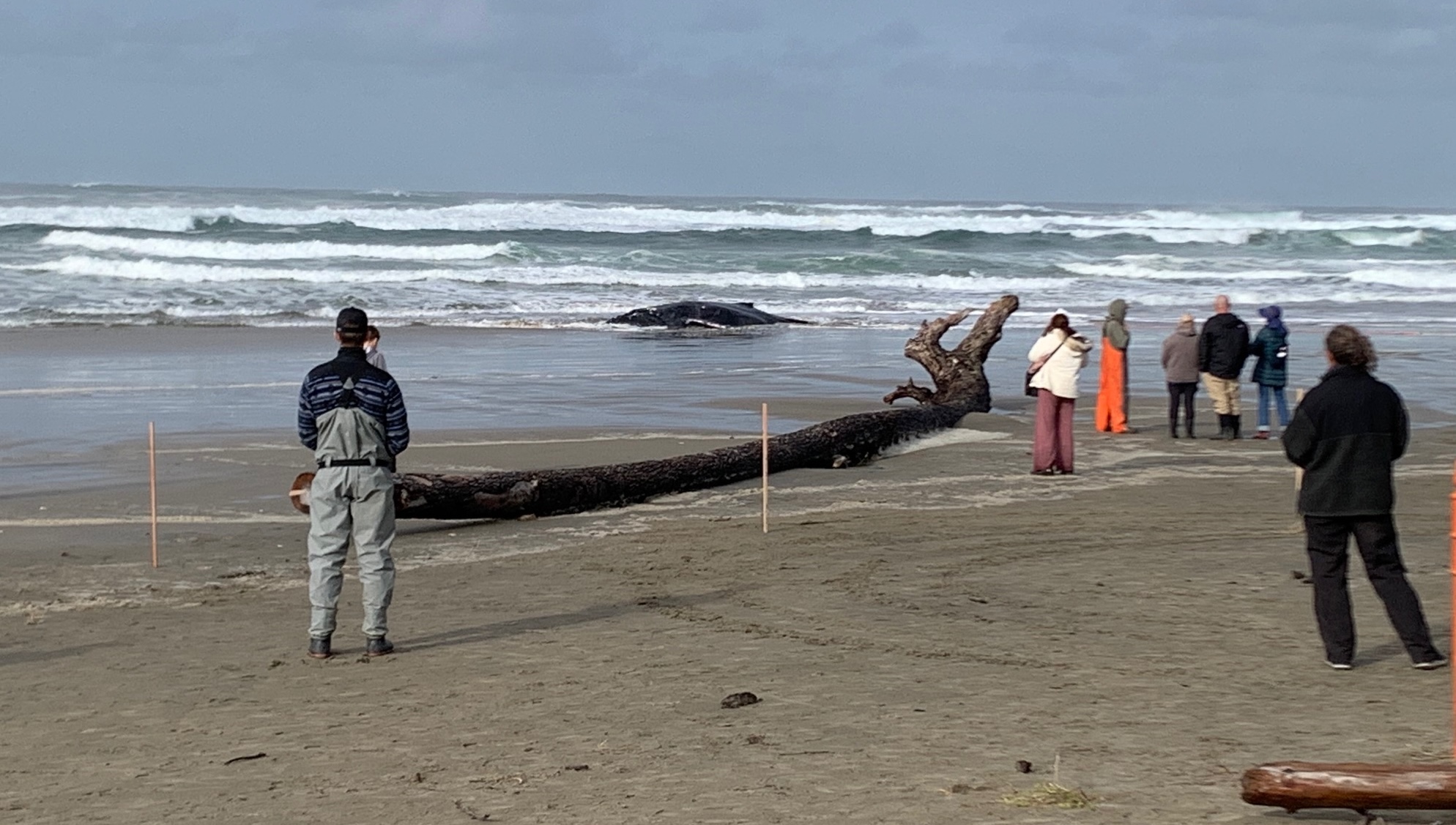
How the Siletz heard
The young humpback whale came ashore north of Yachats last Saturday afternoon. Over the next 48 hours, people flocked to the beach to help the still-living whale, despite urges from the Oregon Marine Mammal Stranding Network not to do so. Online, thousands watched a live stream of the event, pouring out their sympathies for the animal in Facebook comments.
Meanwhile, 50 miles up the coast, Siletz tribal members were gathered at the Chinook Winds Casino Resort for the tribe’s annual Restoration Powwow, which celebrates the restoration of the tribe’s federal recognition in 1977. Word about the whale spread around the powwow, where some prayed and danced for the whale, Norton said.
On Monday, when it was clear the humpback would not survive and would ultimately need to be euthanized, Oregon State Police, which had previously worked with the tribe, reached out about the possibility of harvesting the animal.
The tribe rushed to secure the proper permits and assembled a team of hunters to take apart the whale.
“What an incredible privilege and a daunting task,” Norton said. “The folks that stood up and said ‘we could do this’ were very brave. And what they did was a very important piece to the next chapter of this whale.”
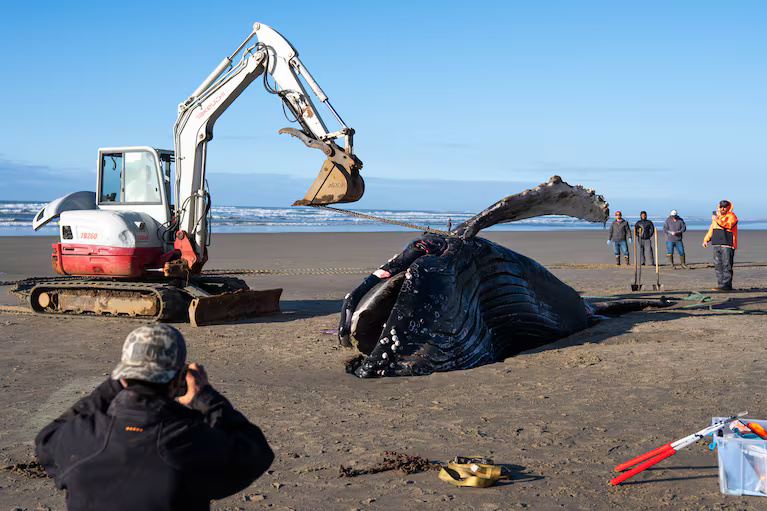
On the beach
The Siletz hunters got to the beach about noon Tuesday, when a crowd of people was already gathered around the whale.

Members of the West Coast Marine Mammal Stranding Network, the Oregon State University Marine Mammal Institute, Oregon State Parks, Oregon Fish and Wildlife Department and half a dozen other agencies had spent days with the whale, trying to find a way for it to survive. After performing a final necropsy, those agencies stepped back to allow the tribe to take over.
Before anyone cut into the animal, they smudged and prayed over its body. They honored the animal for its sacrifice. They offered thanks to the bounty it provided. They asked Creator to guide their hands.
“That is what you do,” Norton said. “As experienced hunters we always give thanks to what has been provided.”
Some members of the team had stayed up late Monday night, researching the bone structure of humpback whales, which parts should be taken, how to cut into the animal. Once on the beach, they also relied on their own instinct as hunters. But the whale was very different from an elk, Norton said, and not just because it was 30 times as big.
The team already knew that unlike the tribe’s ancestors, they wouldn’t harvest any meat from the whale. Since the animal had been chemically sedated and euthanized, everyone was concerned the meat wouldn’t be safe for human consumption. But there was still plenty to harvest. The team took most of the whale’s blubber, thousands of pounds of it, as well as virtually all its bones. They also separated the head so they could later harvest the baleen, the keratin structure that helps the whale filter feed in the ocean.
As they worked into the night, the tribe got a helping hand from Tru-North Construction, local contractors who were on site with heavy equipment. The contractors used an excavator to dig a trench to bury much of the whale meat, organs and final bits of skeleton that wouldn’t be used and helped maneuver the animal around for the team of harvesters. The company also provided a flatbed truck to help transport what the tribe had harvested.
Lorin Lynch, owner of Tru-North, said he had been at the beach for three days helping the efforts to save the whale. He said he was frustrated at how officials handled the situation and unhappy with the decision to chemically euthanize the whale, but ultimately was more than happy to help the tribe harvest the body.
“My whole perspective in life is to train to help others,” Lynch said. “We were there willing to help, whatever they asked for whatever they needed.”

When the sun rose over the beach the next morning, the spot where people had spent days trying to save the dying whale was now a mess of meat and skin — food for the foragers that would clean it all up.
To some, it may seem like a gruesome end to a tragic story, Norton said, but for the tribe it was a heartfelt experience that honored the life so many had tried to save.
“As we were processing and collecting these materials, folks were telling us the stories of how strong this whale was,” Norton said. “That story will stay with each of those pieces that are then put back out in the world.”
The tribe has not yet decided what, exactly, they’re going to do with the animal parts but have put the word out to tribal members to attend meetings this weekend in Siletz to discuss ideas. They plan to render the blubber down to oil, but they’re first going to check to make sure it isn’t toxic. Whale bones have historically been used to make tools or art, which are possibilities, Norton said, and baleen can be used to decorate regalia. One elder told her that a large whale vertebrae makes a nice stool.
“We anticipate that this process is going to continue for a year or two until it’s done,” Norton said.
In the meantime, Oregon officials will investigate the whale’s death.
NOAA Fisheries linked the gear that entangled the whale to Oregon’s commercial Dungeness crab fishery and is now looking into how the entanglement and stranding happened. Oregon State University’s veterinary diagnostic lab said the whale seemed to be in “fair body condition” at the time of the incident but plans to release more details as they complete the necropsy.
While beached whales are not rare in Oregon, it’s uncommon to see healthy whales wash up alive.
In a cruel irony, had the whale been dead, the Siletz tribe wouldn’t have harvested it, they said. The fact that their beautiful experience was born from tragedy is not lost on them.
“There were tears shed for the whale, but there were tears of joy because of this incredible opportunity,” Norton said. “As sad as it was, it was an abundance.”
- Jamie Hale is a travel and outdoors reporter at The Oregonian/OregonLive and can be reached at JHale@Oregonian.com





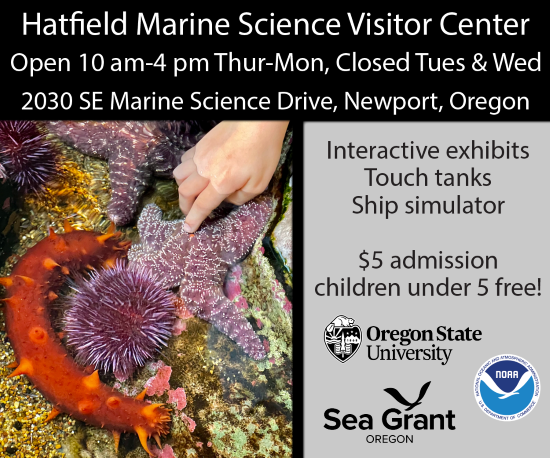







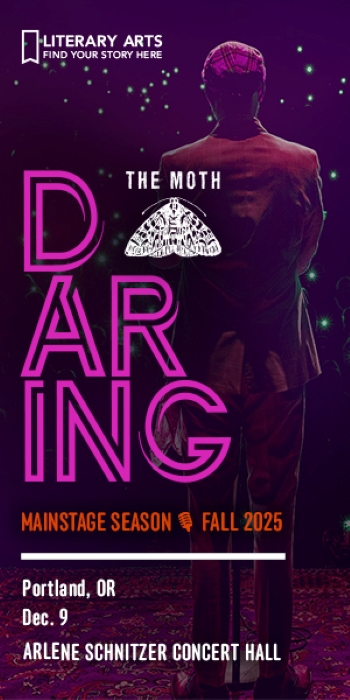
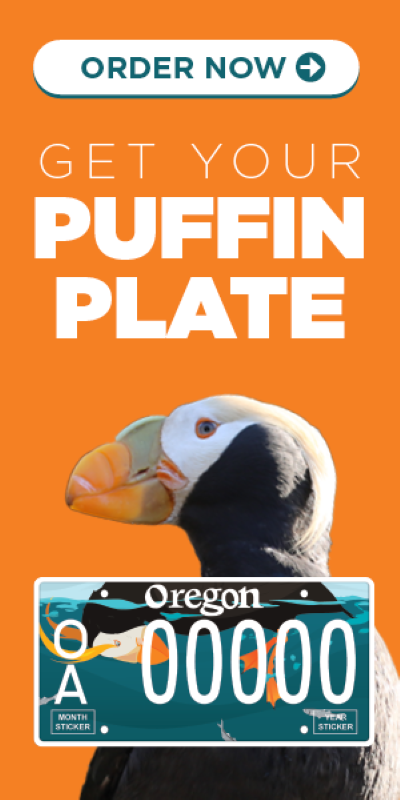



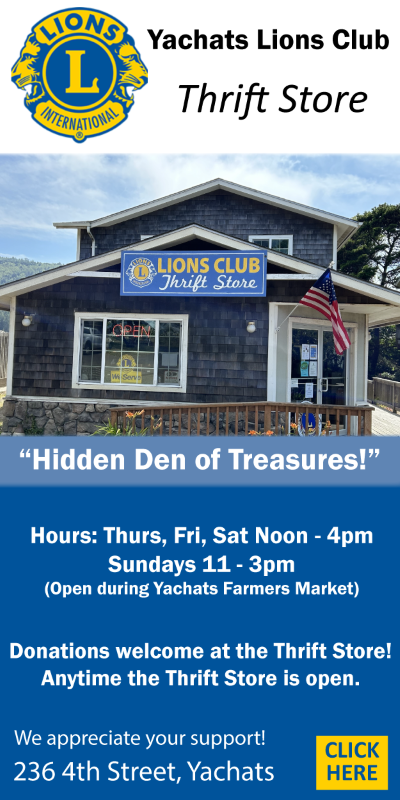
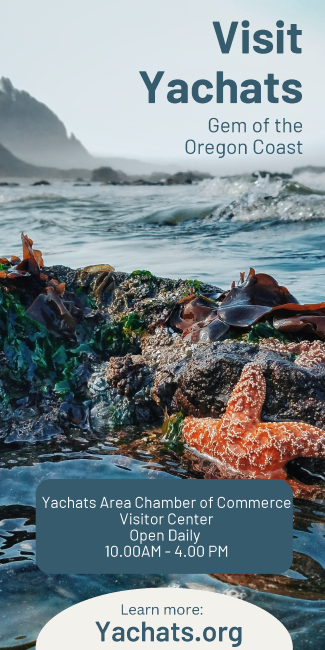
Thank you, Lorin Lynch, owner of Tru-North Construction, for giving your time and resources to Confederated Tribes of Siletz Indians. Qalani.
I’m very unhappy with the commercial Dungeness crab industry that caused this enormous suffering and the obviously ineffective regulatory agencies that could have prevented it. This is a disgrace and a wound for those of us who value all beings.
Hi Oregonians, we are trying to get the attention of legislators to follow California’s lead and fund the replacement of traditional crab pots with whale-safe gear for our crab fisheries. The tragic death of the young humpback whale near Yachats was preventable, but the financial burden of the transition cannot be placed on the backs of the fishermen. Please read, sign and share. Thank you!
https://www.thepetitionsite.com/916/824/804/hope%E2%80%99s-legacy-demand-the-funding-of-whale-safe-crab-pots-in-oregon/
I live in Florence and this is yet another sad story of a whale washing up on the Oregon coast. I applaud the attempt of everyone involved trying exhaustingly to save this young whale. I’m shocked that it was euthanized without trying other measures to save it. Why weren’t more fishing boats used?! I think better decisions could have saved it. At least the body wasn’t a total waste.